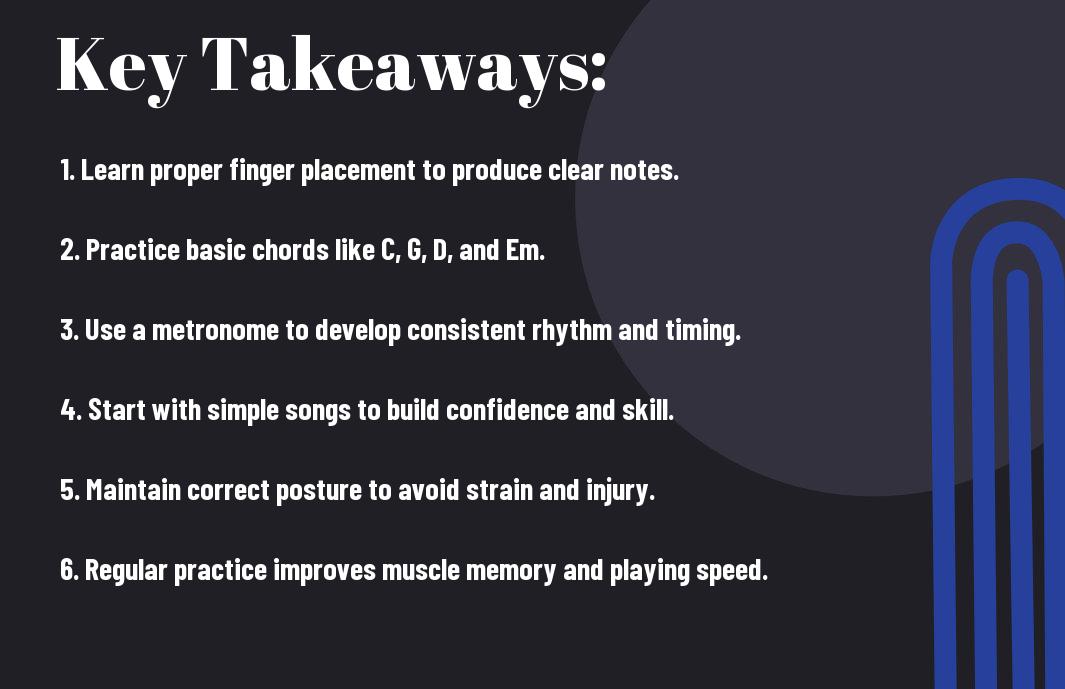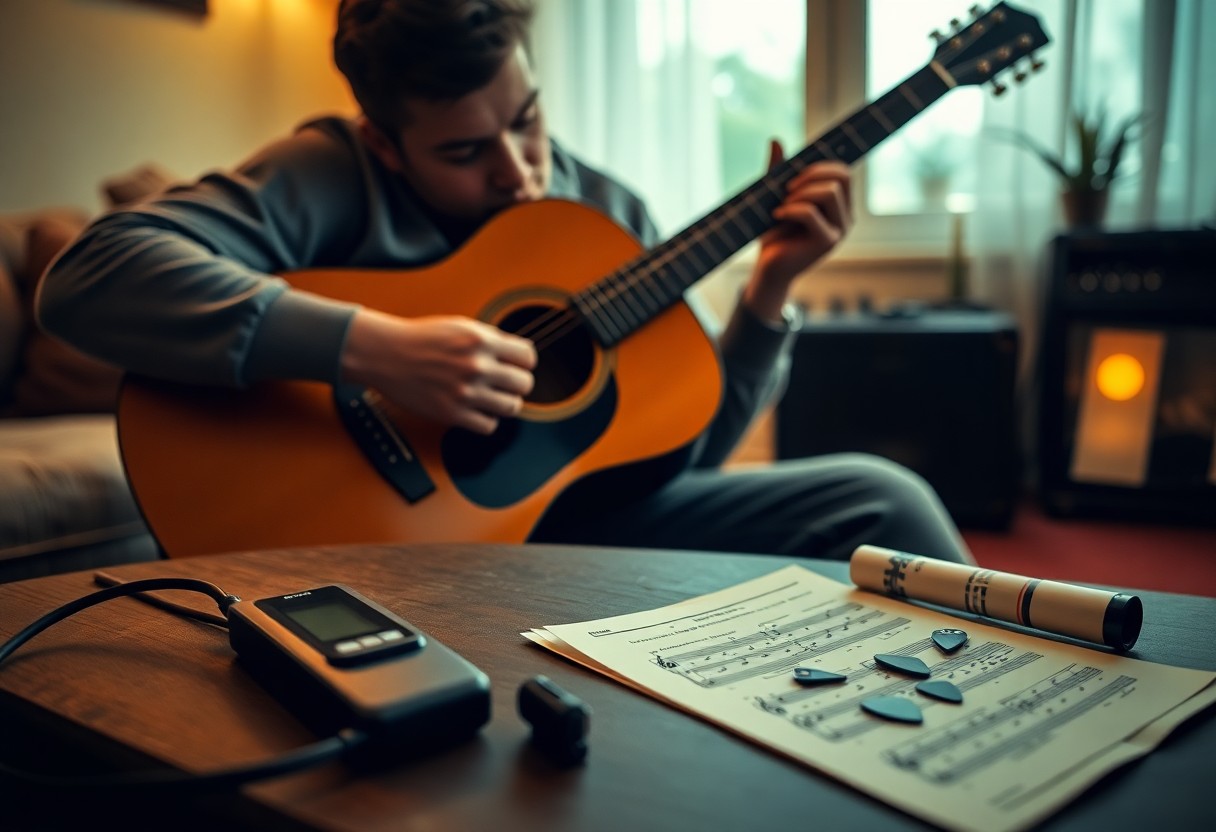There’s a thrilling journey ahead when you pick up a guitar for the first time. I will guide you through some important fundamentals that will not only make you a proficient player but also ensure you enjoy the process. Whether you want to strum your favorite songs or look into intricate solos, mastering your instrument starts here. I’ll cover important topics like proper tuning, basic chord structures, and effective practice techniques, enabling you to build a solid foundation that will serve your musical aspirations. Let’s get started on your guitar journey!

Essential Gear: The Instruments of Expression
Equipping yourself with the right gear is imperative for fully expressing your musical creativity. Each piece of equipment serves a specific purpose, allowing you to explore different sounds and styles. From the guitar itself to the accessories that enhance your playing experience, knowing what you need will empower you on your journey. In this section, I’ll help you navigate the options available, ensuring you find the items that will best support your growth as a musician.
Choosing the Right Guitar: Acoustic vs. Electric
The choice between an acoustic or electric guitar significantly impacts your playing style and musical direction. Acoustic guitars are typically more straightforward, requiring no additional equipment and offering a warm, organic sound suitable for folk or singer-songwriter genres. On the other hand, electric guitars open up a world of effects, versatility, and styles like rock and jazz but require an amplifier and additional gear. Assess your musical preferences before deciding which type aligns with your goals.
Must-Have Accessories for Every Beginner
Essential accessories enhance the playing experience and make learning easier. I highly recommend starting with a quality tuner, picks in various thicknesses, a comfortable strap, and extra strings. A capo is also useful for experimenting with different sounds and changing keys quickly. Investing in a sturdy case or gig bag can protect your guitar, ensuring it lasts longer and remains in great condition.
A quality tuner is non-negotiable, as it helps ensure your guitar sounds its best and supports your learning process. Having a selection of picks allows you to experiment with different playing styles, giving you varied tones and techniques. A comfortable strap makes playing for extended periods more enjoyable, while extra strings ensure you’re never caught with a broken string during practice or performances. A capo is an invaluable tool, letting you easily change keys without needing to learn new fingerings. Lastly, a padded case or gig bag protects your instrument, allowing you to transport your guitar safely while also encouraging you to take it with you wherever you go. Each of these accessories plays a role in fostering a smooth and encouraging learning experience.
The Language of Music: Reading and Understanding Notation
Understanding the language of music opens up a whole new world for your guitar playing. By learning to read and interpret musical notation, you’re not just deciphering symbols; you’re gaining access to countless pieces of music waiting to be explored. For additional insights, I recommend checking out the [newbie] what are the basics every guitarist should master … on Reddit for beginner-friendly resources and tips on this journey.
Deciphering Tabs and Sheet Music
Tabs and sheet music serve as the written instructions for guitarists. Guitar tablature, or tabs, portrays finger placement on the fretboard, making it easier for beginners to learn songs quickly. Sheet music, although more complex, provides a comprehensive understanding of rhythm and melody. Ultimately, mastering both forms allows you to play a wider variety of music styles and enhances your overall musicality.
Key Signatures and Scales: Your Musical Alphabet
Key signatures define the tonal center of your music and indicate which notes are sharp or flat throughout a piece, guiding your improvisations and compositions. Scales, on the other hand, serve as the basic building blocks for melodies and solos, with major and minor scales being the most common. Familiarizing yourself with these concepts equips you with the foundational tools necessary to create and understand a diverse range of music.
Delving deeper into key signatures reveals their significance in establishing the mood of a piece. For instance, the key of C major, which contains no sharps or flats, often evokes a bright and uplifting feeling, while the key of A minor, which is its relative minor, tends to convey a more somber tone. Each scale is built on intervals, and understanding scales helps in crafting your solos and improvisations. For example, the pentatonic scale is extremely popular among guitarists for its versatility and ease of use in blues and rock music. Knowing your scales and key signatures establishes a solid foundation for your musical journey, enabling you to navigate the fretboard with confidence.
Building Strong Foundations: Basic Chords and Progressions
A solid understanding of basic chords and progressions lays the groundwork for your guitar journey. Starting with fundamental chords enables you to play a variety of songs and develop your skills more effectively. As you explore various chord shapes, you’ll notice that many popular songs rely on simple progressions. This familiarity helps you build confidence and encourages musical creativity. Let’s probe the important chords and learn how to connect them smoothly for a more fluid playing experience.
The Most Common Chords Every Beginner Should Know
Focusing on a handful of basic chords will kick-start your guitar journey. Start with the major chords: C, G, D, A, and E. Incorporate minor chords like Am, Em, and Dm to expand your repertoire. Mastering these important chords provides a strong foundation, allowing you to play countless popular songs that utilize these very shapes. Take your time to familiarize yourself with their positions, as this will make transitioning to more complex chords much easier.
Transitioning Smoothly Between Chords
Mastering chord transitions is key to achieving a seamless sound while playing. Begin by practicing switching between two chords, like G and C. Focus on lifting only the fingers necessary to change chords, while keeping others pressed down. Incorporate a metronome to maintain a steady rhythm, gradually increasing the speed as you become comfortable. With consistent practice, your transitions will become smoother, enhancing your overall playing ability and musical expression.
To transition smoothly, break down the movements into smaller steps. For instance, when moving from G to C, visualize the next chord shape before you lift your fingers, which helps in maintaining the flow. You can even practice reducing the lift of your fingers, allowing them to hover just above the fretboard when switching. Frequent repetition will strengthen your muscle memory, helping you make clean, fluid changes between chords without missing a beat — a skill that truly elevates your performance.
Tuning Techniques: Finding Your Sound
An crucial part of playing guitar is ensuring your instrument is perfectly in tune. Without proper tuning, even the most skilled players will struggle to create music that sounds harmonious. Techniques vary based on personal preference and the equipment you have on hand, but learning how to tune your guitar will make a world of difference in your overall sound quality and performance.
Different Methods for Tuning Your Guitar
You have various options for tuning your guitar, each with its own advantages. A chromatic tuner is user-friendly and provides precise tuning by detecting the pitch of each string. Alternatively, using a tuning app on your smartphone combines technology and accessibility. If you prefer a more traditional approach, you can tune by ear using a piano or tuning fork. Finally, the fifth-fret method allows you to match fretted notes across strings, which is particularly helpful when you’re in a jamming session without a tuner.
The Importance of Intonation and Maintenance
Intonation plays a significant role in the overall tuning of your guitar. If the strings are not properly intonated, you might find certain notes sound off when played higher up the neck. This discrepancy arises from the relation of string length, gauge, and action. Regularly checking intonation ensures that your guitar plays in tune across the fretboard. Furthermore, keeping your guitar well-maintained enhances sound quality; clean frets, properly conditioned wood, and properly adjusted hardware can all contribute to a clearer tone and more enjoyable playing experience.
By focusing on intonation, I can identify issues that may arise when certain notes sound out of tune despite regular tuning sessions. The adjustment of bridge saddles, for instance, can correct any discrepancies caused by string tension and length. It’s just as vital to maintain the guitar itself; changing strings often, cleaning the fretboard, and checking the neck relief can keep the instrument in optimal playing condition. This attention to detail not only enhances your sound but also prolongs your guitar’s life, helping to maintain your passion for playing.
Playing Techniques: Strumming and Picking
Mastering playing techniques such as strumming and picking will significantly enhance your guitar skills. Strumming involves using a pick or your fingers to brush across the strings, creating rhythmic sounds that form the backbone of many songs. Picking, on the other hand, focuses on plucking individual strings either with a pick or your fingers, often leading to a more intricate and melodic sound. Both techniques have their unique benefits, and learning them will allow you to express yourself musically in various genres.
The Art of Strumming Patterns and Rhythms
Strumming patterns and rhythms lay the foundational groove for any guitar playing. I find that different genres require specific patterns, and experimenting with them opens up countless sonic possibilities. Basic patterns often include downstrokes and upstrokes, with more complex rhythms incorporating syncopation. Practicing these patterns with a metronome helps refine timing, ensuring that your strumming complements the song effectively. Once you get comfortable, try to combine different patterns to suit your own style.
Fingerpicking vs. Flatpicking: A Comparison
Choosing between fingerpicking and flatpicking depends on the sound and style you’re aiming to achieve. Fingerpicking enables intricate melodies and harmonies, while flatpicking is ideal for a more percussive and rhythmic approach. I find that fingerstyle offers a richer texture, especially in genres like folk and classical, while flatpicking shines in bluegrass and country contexts. Ultimately, mastering both techniques expands your musical palette and invites creative exploration.
| Technique | Description |
| Fingerpicking | Utilizes the fingers to pluck individual strings, allowing for complex melodies and harmonies. |
| Flatpicking | Involves using a pick to strum or pluck strings, offering a sharper, more pronounced sound. |
Fingerpicking often produces softer, more nuanced sounds, making it excellent for ballads and slower songs. Many iconic artists, like James Taylor and Paul Simon, have popularized this technique. In contrast, flatpicking allows for a brighter sound, making it effective in fast-paced genres like bluegrass, where speed and clarity are vital. Notable players like Doc Watson and Tony Rice showcase the dazzling effects achievable with flatpicking. Understanding the strengths of each method will help you decide which to incorporate into your playing style and repertoire.
Final Words
Presently, as you commence on your journey into guitar basics, I encourage you to practice consistently and embrace the learning process. Understanding the fundamentals of chords, strumming patterns, and finger placement will lay a solid foundation for your musical adventures. I assure you that with patience and dedication, you will see progress and find joy in playing the guitar. So, pick up your instrument, and let the music flow as you grow as a musician!




